A Holistic Approach to Spring Rejuvenation
authored by Taylor Appel, Registered Herbalist (AHG)
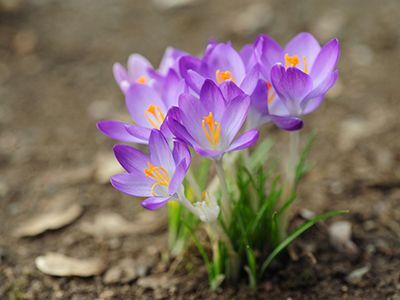
Signs of spring are emerging everywhere. Just as nature is getting ready to blossom, our bodies are also moving through a significant transition from our quieter winter routines into a more spring-like, outward expression of our energy. This is a time in nature when both animals and plants are emerging from deep rest and there are signs of life all around. We can also recognize these same patterns within ourselves. For example, you might feel the urge to spend more time outside or be more active in your daily life.
This is prime time to do spring cleaning in the body by supporting its detoxification pathways. As the days get longer, and the sun shines brighter, we can care for our body's physical, mental, and emotional needs by utilizing seasonally appropriate lifestyle and dietary changes that will help us feel energized and rejuvenated!
Foods for Spring
Seasonal dietary changes are important for more dramatic transitions, such as winter into spring, when our bodies may need a bit more support than other times of the year. Focus on consuming foods that are high in vitamins and minerals to boost the immune system and help you become more resilient to any flus that comes your way. Choose fruits and vegetables, always organic when possible, that are in season for this time of year as an easy way to not only support your personal health, but also the health of our planet. To promote healthy detoxification during spring, eat glutathione, quercetin, and vitamin C-rich foods like avocados, walnuts, asparagus, spinach, okra, potatoes, onions, broccoli, garlic, citrus, berries, and carrots.
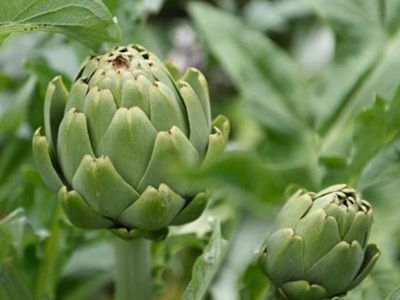
Each season provides an abundance of fruits and vegetables that are at their peak in flavor, color, and fragrance. This is why buying seasonal produce is always recommended -- you can truly taste the difference and seasonal items are usually cheaper than those purchased out of season. Not sure what’s in season for your area? Check out your local farmer’s market – if it’s not being sold fresh there, it’s probably not technically “in-season” in your region. You can always refer to a farmer’s almanac as another helpful resource to help you eat more in alignment with the seasons.
March officially marks the true transition into spring, and depending where you live, this also signifies the beginning of some of the most versatile fruits and vegetables we have, which are tremendously nutritious and are absolutely delicious in various preparations. Some of March’s seasonal offerings include1:
Vegetables:
| artichokes | arugula | avocado | asparagus |
| beets | bok choy | broccoli | Brussel sprouts |
| cabage | carrots | cauliflower | celery |
| collard greens | cucumber | endive | fennel |
| kale | leeks | parsnips | onions |
| potatoes | radishes | radicchio | spinach |
| sunchokes | spring onions | sweet potato | turnips |
Fruits:
| apples | grapefruit | kiwi | lemon, lime |
| oranges | pear | persimmon | strawberries |
There are so many ways to utilize these seasonal fruits and vegetables. From curries to salads, eaten fresh or baked into treats -- there are really so many options this time of year!
Recipes for Spring
Here are a few recipes utilizing some of the fantastic produce March has to offer:
Carrot Cake Overnight Oats
Prep Time: 10 mins
Chill Time: 4 hrs
Total Time: 4 hrs 10 mins
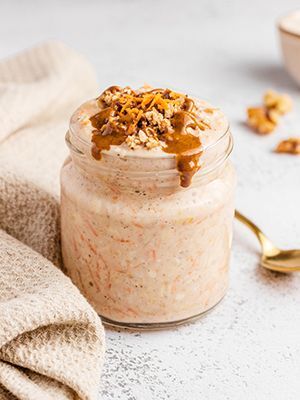
Ingredients
- 4 1/2 cup rolled oats or quick oats
- 1 cup organic soy milk or almond milk or your favorite milk
- 1/2 teaspoon vanilla extract
- Pinch of salt
- 1/2 banana mashed
- 1 tablespoon hemp seeds
- 1/2 teaspoon Ceylon cinnamon
- 1/8 teaspoon ginger freshly grated
- Pinch of nutmeg
- 1/4 cup carrot grated
- 1 tablespoon walnuts chopped
- 1 tablespoon raisins
Instructions
- Add oats, milk, vanilla, mashed banana, hemp seeds, and spices to mason jar. Shake jar or mix and combine with a spoon.
- Mix in grated carrots, chopped walnuts, and raisins.
- Seal and chill in the fridge for at least 4 hours or overnight.
- Serve with more milk if desired and sprinkle with additional walnuts, carrots, and raisins before serving (optional).1
Recipe and photo source: https://www.natalieshealth.com/carrot-cake-overnight-oats/
Broccoli Kale Salad With Tahini Dressing
Prep Time: 10 mins
Cook Time: 20 mins
Chill: 30 mins
Total Time: 1 hr
Servings: 4-6 as a side dish, 2-3 as a main dish
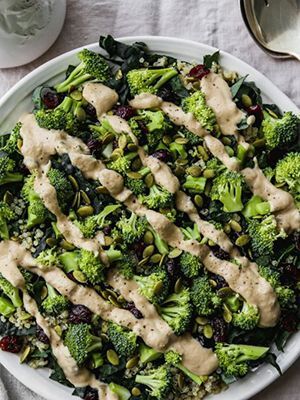
Ingredients
- 5 cups lacinato kale, shredded (about 1 large bunch - how to massage kale for salad)
- 2 cups raw broccoli, chopped (about 1 large crown)
- 1/3 cup quinoa, dry (or 1 cup cooked)
- 1/4 cup dried cranberries (unsweetened if possible)
- 1/4 cup pumpkin seeds, raw
- Salt + pepper, to taste
Tahini Dressing
- 1/2 cup tahini
- 1/4 cup red wine vinegar
- 1 tsp pure maple syrup
- 1 tsp garlic powder (or 2 cloves)
- 2 Tbsp lemon juice
- 1/4 cup water (to thin dressing)
- Salt + pepper, to taste
Instructions
- Cook quinoa according to package directions (or see detailed tips here).
- While quinoa cooks, shred kale and chop broccoli into smaller pieces. The florets can be cut in roughly 1/2-inch pieces and the stalks about 1/4-inch pieces. Set aside.
- Make tahini dressing by adding all dressing ingredients together in a small bowl. Whisk together until smooth, adjusting seasonings to taste.
- Add shredded kale, chopped broccoli, cooked quinoa, dried cranberries, and pumpkin seeds to a large mixing bowl. Pour dressing over the top and toss everything together well, ensuring that the dressing really coats all of the salad. Season with extra salt and pepper as needed.
- Cover and refrigerate salad for at least 30 minutes to allow it to chill and the kale to soften before eating.
While the exact size of bunches of kale and crowns of broccoli of differ, the recipe above was made with a large bunch of kale and a large crown of broccoli, and it yielded the amounts you see listed. If you can only find smaller bunches of kale, use at least 2. You can make this dish in advance because the flavors sink in and the kale gets softer (but not soggy)! Leftovers will keep in an airtight container in the fridge for about 3 days.
Recipe and photo source: https://www.walderwellness.com/broccoli-kale-salad-tahini-dressing/
Detox for Spring
In addition to making seasonal dietary choices, there are also numerous shifts we can make in our daily routines that will help our bodies transition more easily into spring and these longer, warmer days. Treating our bodies well during times of seasonal changes is important for promoting overall health and well-being. One of the ways we can do this is by supporting the body’s detoxification pathways. These include the liver, skin, kidneys, digestive system, and lungs. Each system does its part to efficiently remove toxins from the body, helping to lower inflammation and reduce the probability of health issues occurring in the future. Optimizing these detoxification pathways can have a positive ripple effect on every aspect of our lives from our energy to our mood.2 Implement some of the tips below to help support your body’s seasonal “spring cleaning”:

How to lower your toxin exposure:
Clean Food: Consider buying only organic fruits and vegetables. Limiting your exposure to glyphosate and other harmful pesticides and herbicides has been found to be a prophylactic way to avoid unnecessary toxins.
Clean Air: Get outside into nature, especially in spaces that are surrounded by trees. Also, utilizing air purifiers in indoor spaces is a great way to filter out any toxins in more stagnant air.
Clean Water: Consider installing a full-house water filtration system that will allow you to feel confident you are not showering, drinking, or cooking with water contaminated by heavy metals, medications, and more. You can also look-up your local water quality at https://www.ewg.org/tapwater/
Self-care tips to support detoxification pathways:
- Get enough rest (try for 8 hours each night)
- Focus on hydration (with electrolytes)
- Go to the bathroom each day (at least 1 bowel movement daily)
- Sweat it out! (use a sauna or get outside and exercise)
- Epsom salt/magnesium baths (relaxes and detoxifies)
- Avoid inflammatory products (scented items, food additives/dyes/flavors, refined sugar, etc.)
- Lower stress levels (practice mindfulness, meditation, and breathing techniques)
Herbs for Detoxification
Beyond lifestyle and dietary modifications, consuming healing herbs can be another proactive way to support an easier transition into spring. The botanicals below help optimize liver health, the main detoxification organ, as well as provide numerous therapeutic and nutritive qualities.
Green tea (Camellia sinensis)
Green tea has been used since at least 3000 B.C. to help promote vitality, longevity, improve cognitive health, and boost immune health to protect from disease. Green tea boasts a powerhouse of antioxidant polyphenols that research finds to be incredibly effective in reducing free radical damage caused by things like stress, poor food choices, and illness. It also helps promote proper detoxification of toxins from the body. Green tea has also been studied for its anti-cancer and cancer preventive properties, specifically helping to regulate female hormone levels that may contribute to reproductive system cancers. Green tea does contain caffeine, but it also has L-theanine, which balances the stimulating action of green tea, making it gentler on the nervous system. Green tea makes a delicious beverage both hot or cold, making it perfect for the transitional weather of springtime.3
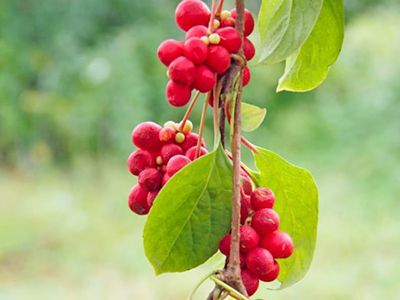
Schisandra Berry (Schisandra chinensis)
Schisandra berry or Wu-Wei-Zi, meaning, "the fruit of five tastes" in Chinese, is commonly used in traditional Chinese medicine for its “Qi-invigorating” properties that help restore a feeling of vitality and energy throughout the body. In traditional Russian medicine, Schisandra was described as a tonic for reducing hunger, fatigue, delaying the aging process, increasing vitality, and improving mental health. Modern research shows that it may also be especially beneficial for liver health and the detoxification process. In numerous studies, Schisandra was found to be protective against liver damage by activating enzymes that produce glutathione, helping to repair cells and aid in quicker recovery from sickness and stress. Schisandra berry powder makes a fantastic addition to homemade applesauce, and the whole berries make a deliciously refreshing and beautifully colored antioxidant-rich tea.3
Springtime is truly a season of renewal and by implementing a few lifestyle and dietary changes, you can make this year’s seasonal transition a breeze. Consider eating seasonal fruits and vegetables, doing a few self-care practices, and adding liver-loving herbs into your routine. There is no better time to prepare for these seasonal changes than today and we hope you enjoy all the beauty this time of year has to offer!
Join the Mederi Center community by signing up for our email list! We send several emails a month with product promotions for patients, practical tips for healthy living, blogs written by our practitioners, information about events, and other news. You can unsubscribe at any time.
References
- What's in season: March: Guide and recipes included! Natalie's Health, originally published March 9, 2022 at https://www.natalieshealth.com/whats-in-season-march/.
- Hodges RE, Minich DM. Modulation of Metabolic Detoxification Pathways Using Foods and Food-Derived Components: A Scientific Review with Clinical Application. J Nutr Metab. 2015;2015:760689. doi:10.1155/2015/760689
- Grant DM. Detoxification pathways in the liver. J Inherit Metab Dis. 1991;14(4):421-430. doi:10.1007/BF01797915
- Marciano, M., & Vizniak, N. A. (2015). In Evidence informed Botanical Medicine. essay, Professional Health Systems Inc. Accessed 1/29/2023.


